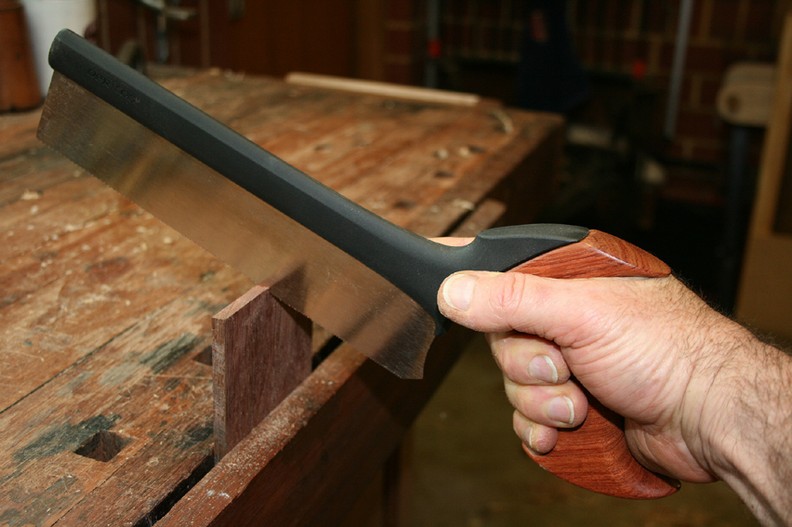Sheffield Tony
Ghost of the disenchanted
We mentioned this saw in an earlier thread.
I will admit up front that I am not the most experienced at cutting dovetails, but I have done a few, and tried pretty much all types including mitred, and have been by and large satisfied with the results. Mostly without the aid of a proper dovetail saw, but using a small tenon saw that was my Grandad's - a S&J "Cockerill", presumably 1970's, not hardpoint but with a plastic handle and steel back.
I bought myself a Veritas saw, the 14tpi rip cut dovetail saw, in the hope it would make life easier. I kind of liked it when it arrived, but have not used it much until now. I'm making a small bookcase, of oak, with the top being joined to the sides with lapped dovetails. Pretty conspicuous, so a good chance to use my new saw. But I am finding that each time I use it, I love it a little bit less.
Years back, when I learned how to cut joints, I was told that, if you position your head directly over the cut, you can, by virtue of the separation of your eyes, see down both sides of the saw plate at the same time, and by sighting down your mark, follow the line quite nicely. A small movement of your head is reflected in the angle of the cut. Works well for me. But - if I try this with the Veritas saw - the entire saw blade, my marking out - everything is obscured by the fat composite spine ! To see where I'm cutting, I have to look down one side or the other, which I find much less easy.
This would not be so bad if it weren't for the minimal set, that means once started a tad off, there is no wriggle room to correct the mistake.
I'm struggling with the handle too. I know that dovetail saws normally have a less vertical angle than a tenon saw (though not why), but I find myself gripping this in all sorts of uncomfortable ways to make a horizontal bottom to my cut. Perhaps it is because I'm used to using the small tenon saw.
Perhaps I'm doing it all wrong, have got into bad habits etc. Maybe I need mroe practice with it. Maybe I just bought the wrong saw for me. What do you reckon ? I'd appreciate any correction from users who do like them !
I will admit up front that I am not the most experienced at cutting dovetails, but I have done a few, and tried pretty much all types including mitred, and have been by and large satisfied with the results. Mostly without the aid of a proper dovetail saw, but using a small tenon saw that was my Grandad's - a S&J "Cockerill", presumably 1970's, not hardpoint but with a plastic handle and steel back.
I bought myself a Veritas saw, the 14tpi rip cut dovetail saw, in the hope it would make life easier. I kind of liked it when it arrived, but have not used it much until now. I'm making a small bookcase, of oak, with the top being joined to the sides with lapped dovetails. Pretty conspicuous, so a good chance to use my new saw. But I am finding that each time I use it, I love it a little bit less.
Years back, when I learned how to cut joints, I was told that, if you position your head directly over the cut, you can, by virtue of the separation of your eyes, see down both sides of the saw plate at the same time, and by sighting down your mark, follow the line quite nicely. A small movement of your head is reflected in the angle of the cut. Works well for me. But - if I try this with the Veritas saw - the entire saw blade, my marking out - everything is obscured by the fat composite spine ! To see where I'm cutting, I have to look down one side or the other, which I find much less easy.
This would not be so bad if it weren't for the minimal set, that means once started a tad off, there is no wriggle room to correct the mistake.
I'm struggling with the handle too. I know that dovetail saws normally have a less vertical angle than a tenon saw (though not why), but I find myself gripping this in all sorts of uncomfortable ways to make a horizontal bottom to my cut. Perhaps it is because I'm used to using the small tenon saw.
Perhaps I'm doing it all wrong, have got into bad habits etc. Maybe I need mroe practice with it. Maybe I just bought the wrong saw for me. What do you reckon ? I'd appreciate any correction from users who do like them !





